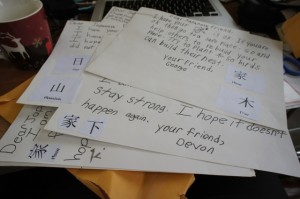As part of an occasional series, Sheila Burt (Toyama-ken, 2010-2012) will begin profiling JETs who are or were in some way involved with rebuilding efforts in the Tohoku region. The inaugural post is about Jessie Zanutig (Gunma-ken, 2009-12), who founded 3,000 Letters to Japan, an international letter exchange project aimed at lifting the spirits of students who are living in the communities hardest hit by the disaster. Burt is currently a freelance journalist and English teacher in Matsuyama City, Ehime-ken. Read more of her reporting at her blog, Stories from the Inaka.
Jessie Zanutig was in the middle of celebrating her junior high school students’ graduation at a small restaurant in Kawaba Village, Gunma Prefecture, when the earthquake struck. Buildings in her tiny mountainous town in northern Gunma shook violently, but her town was thankfully safe from the tsunami that was about to ravage several coastal communities in northeast Japan.
As Gunma residents banned together in the next few weeks to send supplies to neighboring Fukushima-ken, Zanutig began to correspond with a Canadian friend who was living in Ishinomaki, one of the hardest hit towns in Miyagi Prefecture, to learn more about the situation. Her friend’s boyfriend, who is Japanese, lost his father in the tsunami and was struggling with the sudden loss of a family member.
“I was in contact with her a lot to make sure she was OK. Her students were having a really hard time,” Zanutig, 28, remembers. “I thought, ‘I want to help but there’s nothing I can do.’ So I asked her, ‘If I just collected a few letters from friends and family, do you have a few students you can give them to?’”
Her friend agreed, and Zanutig sent an invitation to friends in Gunma and around Japan to write letters to students who were most affected by the triple disasters. Soon, her home’s tiny mailbox was overflowing with letters from around the world. Her town’s postal delivery woman began bringing boxes of letters directly to the junior high school where Zanutig worked. Every morning, Zanutig and her students would carry the letters to the staff room.
“The goal was to really show the children affected by the earthquake and tsunami that people around the world care about them and think about them,” Zanutig says. “The other goal was to give people a really concrete way of helping, doing something rather than just donating money, a way for people around the world to show that they care.”
“I think the letter is a lost art form. Anyone can sit down and write an e-mail. That’s not the same effort as writing a letter, something physically made for you. There is a lot of effort and kindness that goes into a letter.”
Her initial hope was to deliver 300 letters to students in Tohoku, but after seeing the response from friends and strangers around the world, she changed the name of the project to 3,000 Letters for Japan. Within three months, Zanutig had received about 13,000 letters in total, and in May 2011, she and her boyfriend drove from her village to Miyagi to distribute the letters to ALTs in the area, though some of the delivery process was difficult due to the critical situation in the area.
“A lot of schools were closed down, or ALTs had left,” she says. “It was really hard to distribute, we are a little bit disconnected. It was hard for her to find schools, to say ‘Hey I have these letters from around the world.’”
Still, many of the letters reached students who were eager to hear from a new friend in a different country. Many of the letters came from students who wrote about their own hobbies and what they love about Japan — everyday things that perhaps helped the Tohoku students think about other matters rather than the sadness around them and the grief that consumed so many adults. Zanutig says one of her favorite group of letters came from a junior high class whose students included a photo of themselves in each letter.
“They didn’t talk about how they were sorry for their loss; it was more of a friendship letter,” she says.
Zanutig is now back in her home country of Canada pursing a master’s degree in education with the hopes of teaching at an international school, perhaps once again in Japan. Occasionally, she will hear about someone who received a reply back from a student who received a letter in Tohoku.
Although 3,000 Letters for Japan has closed, Zanutig hopes efforts continue to reach Tohoku, even two years after the disaster.
“I think the earthquake was a really hard time to be in Japan, but when I look back at the three years I was there, it was one of my favorite times. I learned the most about Japan, Japanese people and the Japanese spirit,” she says. “I remember a lot of foreigners left Japan; they were scared. I didn’t leave. I had a strong enough community that I had faith.”




one comment so far...
[…] http://jetwit.com/wordpress/2013/05/19/tohoku-projects-3000-letters-to-japan/ […]